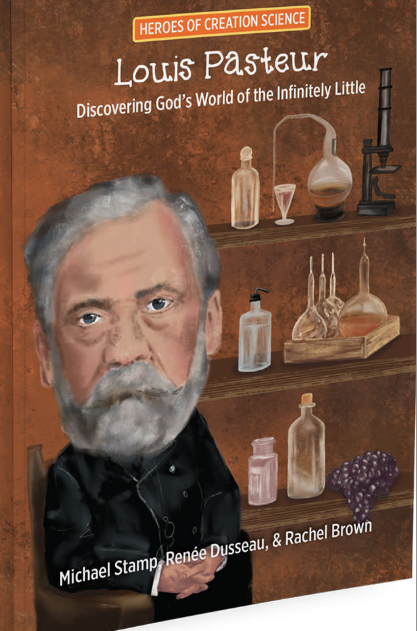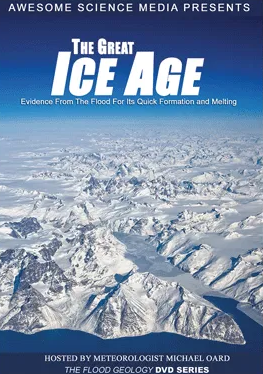Level Legend
 Children
Children Introductory
Introductory
 Intermediate
Intermediate
 Technical
Technical
Articles
The Creation Science Dialogueis a quarterly publication of the Creation Science Association of Alberta (CSAA). Subscription Information.
FEATURED BOOKS AND DVDS
Paperback / $10.00 / 169 Pages / full colour
There are one or more origin sites on a DNA molecule which must be recognized by a protein (dnaA) from outside of the chromosome and which then binds to the DNA at that spot. This binding causes a local distortion in the chromosome, which is recognized by the enzyme helicase and helicase then attaches to the DNA and progressively uncoils the DNA using ATP. As soon as the strands are separated, small binding proteins bind to the exposed nucleotides to prevent rejoining of the strands. A further enzyme, primase kickstarts the DNA polymerase III which attaches partner nucleotides to the new DNA strand, working in opposite directions at the same time. Another enzyme, topoisomerase, ahead of the replication fork, cuts one strand of the DNA polymer’s phosphate backbone and, after unwinding the strands, re-attaches the cut end. Without this complex machinery, the chromosome would become hopelessly tangled!
Concerning DNA replication, one commentator rhetorically asked: “How reasonable is it to believe that a mechanism of this sort of complexity could arise by trial and error processes based on randomly generated mutations. It seems inconceivable.” [David Swift. 2002. Evolution Under the Microscope. p. 190]
Order OnlinePaperback / $6.00 / 55 Pages
There are one or more origin sites on a DNA molecule which must be recognized by a protein (dnaA) from outside of the chromosome and which then binds to the DNA at that spot. This binding causes a local distortion in the chromosome, which is recognized by the enzyme helicase and helicase then attaches to the DNA and progressively uncoils the DNA using ATP. As soon as the strands are separated, small binding proteins bind to the exposed nucleotides to prevent rejoining of the strands. A further enzyme, primase kickstarts the DNA polymerase III which attaches partner nucleotides to the new DNA strand, working in opposite directions at the same time. Another enzyme, topoisomerase, ahead of the replication fork, cuts one strand of the DNA polymer’s phosphate backbone and, after unwinding the strands, re-attaches the cut end. Without this complex machinery, the chromosome would become hopelessly tangled!
Concerning DNA replication, one commentator rhetorically asked: “How reasonable is it to believe that a mechanism of this sort of complexity could arise by trial and error processes based on randomly generated mutations. It seems inconceivable.” [David Swift. 2002. Evolution Under the Microscope. p. 190]
Order OnlinePaperback / $6.00 / 62 Pages / full colour
There are one or more origin sites on a DNA molecule which must be recognized by a protein (dnaA) from outside of the chromosome and which then binds to the DNA at that spot. This binding causes a local distortion in the chromosome, which is recognized by the enzyme helicase and helicase then attaches to the DNA and progressively uncoils the DNA using ATP. As soon as the strands are separated, small binding proteins bind to the exposed nucleotides to prevent rejoining of the strands. A further enzyme, primase kickstarts the DNA polymerase III which attaches partner nucleotides to the new DNA strand, working in opposite directions at the same time. Another enzyme, topoisomerase, ahead of the replication fork, cuts one strand of the DNA polymer’s phosphate backbone and, after unwinding the strands, re-attaches the cut end. Without this complex machinery, the chromosome would become hopelessly tangled!
Concerning DNA replication, one commentator rhetorically asked: “How reasonable is it to believe that a mechanism of this sort of complexity could arise by trial and error processes based on randomly generated mutations. It seems inconceivable.” [David Swift. 2002. Evolution Under the Microscope. p. 190]
Order OnlineDVD / $15.00 / 97 Minutes
There are one or more origin sites on a DNA molecule which must be recognized by a protein (dnaA) from outside of the chromosome and which then binds to the DNA at that spot. This binding causes a local distortion in the chromosome, which is recognized by the enzyme helicase and helicase then attaches to the DNA and progressively uncoils the DNA using ATP. As soon as the strands are separated, small binding proteins bind to the exposed nucleotides to prevent rejoining of the strands. A further enzyme, primase kickstarts the DNA polymerase III which attaches partner nucleotides to the new DNA strand, working in opposite directions at the same time. Another enzyme, topoisomerase, ahead of the replication fork, cuts one strand of the DNA polymer’s phosphate backbone and, after unwinding the strands, re-attaches the cut end. Without this complex machinery, the chromosome would become hopelessly tangled!
Concerning DNA replication, one commentator rhetorically asked: “How reasonable is it to believe that a mechanism of this sort of complexity could arise by trial and error processes based on randomly generated mutations. It seems inconceivable.” [David Swift. 2002. Evolution Under the Microscope. p. 190]
Order Online






